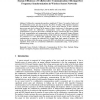Free Online Productivity Tools
i2Speak
i2Symbol
i2OCR
iTex2Img
iWeb2Print
iWeb2Shot
i2Type
iPdf2Split
iPdf2Merge
i2Bopomofo
i2Arabic
i2Style
i2Image
i2PDF
iLatex2Rtf
Sci2ools
110
click to vote
SERSCISA
2010
Springer
2010
Springer
Energy Efficiency of Collaborative Communication with Imperfect Frequency Synchronization in Wireless Sensor Networks
Collaborative communication produces significant (N2 where N is number of nodes used for collaboration) power gain and overcomes the effect of fading. With imperfect frequency synchronization significant but slightly less than N2 power can be achieved. As the N increases more power gain can be achieved at the expense of more circuit power. In this paper an energy consumption model for collaborative communication system with imperfect frequency synchronization is proposed. The model to calculate the energy consumed by the sensor network for local communication and communication with base station is presented. Energy efficiency model for collaborative communication for the off-the shell products (CC2420 and AT86RF212) are presented. It is also shown that significant energy can be saved using collaborative communication as compared to traditional SISO (Single input single output) for products. The break-even distance where the energy consumed by SISO and collaborative communication is als...
Collaborative Communication | Computer Networks | Imperfect Frequency Synchronization | Power Gain | SERSCISA 2010 |
Related Content
| Added | 30 Jan 2011 |
| Updated | 30 Jan 2011 |
| Type | Journal |
| Year | 2010 |
| Where | SERSCISA |
| Authors | Husnain Naqvi, Stevan M. Berber, Zoran A. Salcic |
Comments (0)

